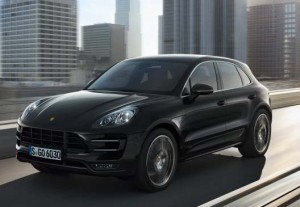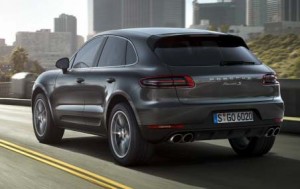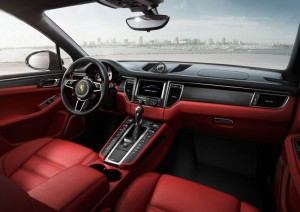Its name comes from the Indonesian word for tiger. As the first Porsche in the compact SUV segment, the Macan combines the handling characteristics that typify Porsche.
The vehicle will be available in two versions: Macan S and Macan Turbo. Standard features include active all-wheel drive and the Porsche double-clutch transmission (PDK).
The Macan S is powered by a new Porsche-designed 3.0-litre V6 bi-turbo engine that delivers 340 hp, can accelerate from 0 to 100 km/h in 5.4 seconds (5.2 with the Sport Chrono package) and consumes 9.0 to 8.7 litres of fuel per 100 kilometres.
The 3.6-litre V6 bi-turbo engine in the Macan Turbo is based on the 3.0-litre V6 unit, with a stroke that has been increased by 83 millimetres. It produces 400 hp and accelerates the vehicle to 100 km/h in as low as 4.8 seconds (4.6 with Sport Chrono), with an average fuel consumption of 9.2 to 8.9 litres per 100 kilometres.
Low-speed fuel efficiency is maximized with the standard engine Start/Stop system.
The all-wheel drive system features a constantly-driven rear axle. If the rear wheels slip, up to 100 per cent of the torque can be transferred to the front via an electronically controlled multi-plate clutch.
An off-road mode is standard in the Macan, and can be activated by pressing a button in the centre console at speeds up to 80 km/h. This function switches all relevant systems to a traction-oriented mode. Shift pattern, front and rear torque split, as well as accelerator pedal response are then geared towards a greater level of traction for off-road conditions.
The clutch is also pre-tensioned to a greater degree in order to provide the front axle with the appropriate torque more rapidly.
With the optional air suspension, ground clearance can be increased by 40 mm to a maximum ground clearance of 230 millimetres on both Macan models.
The Macan S offers standard 18-inch wheels while 19-inch wheels are standard for the Macan Turbo. A vast range of wheels (up to 21 inches in size) are available on all Macan models. The use of mixed tires with different front and rear dimensions is typical of a sports car. On Macan S, 235/60 R 18 (front) and 255/55 R 18 (rear) tires are standard, while Macan Turbo features 235/55 R 19 (front) and 255/50 R 19 (rear). The low centre of gravity and 2,807-millimetre wheelbase, combined with the 1,655-millimetre front and 1,651-millimetres rear track, provide further stability.
Around a quarter of all accidents resulting in injury are referred to as “multi-collision accidents”, where a second collision follows the first. Macan’s multi-collision brake system is designed to reduce the residual kinetic energy following an initial collision by applying braking power. The feature is triggered if airbag sensors detect an initial impact, at which point the system initiates maximum braking to a maximum deceleration force of 0.6 g, ensuring that the driver can maintain control of the vehicle. The system would brake the vehicle until it reaches 10 km/h, allowing to reach a safe location following the braking action. If at any time the driver accelerates or brakes at a higher threshold, multi-collision brake is then deactivated.
The front section is a distinctive component of the Macan’s design. The basic shape of its headlights is reminiscent of the 918 Spyder hybrid super sports car. Bi-Xenon main headlights are available as an option (standard on Macan Turbo) and include static and dynamic cornering lights (Porsche Dynamic Light System (PDLS)). The wraparound aluminium hood encloses the headlights and extends to the wheel arches.
On Macan Turbo, “C-blade” stylistic elements are fitted in the air intakes on the right and left of the vehicle. Another highlight is the presence of “side blades” at the bottom of the front and rear doors. These are finished in Lava Black on Macan S, painted in body colour on Macan Turbo, and can be specified in genuine carbon as an option.
The Macan tail lights are another striking feature, with three-dimensional design and LED technology – a further reference to the 918 Spyder. The rear diffuser is flanked on both sides by twin tailpipes – round on the Macan S and square on the Turbo.
From the forward-sloping centre console to the extensive range of customization options, the interior offers a sense of familiarity and striking new features. A multi-function sport steering wheel with shift paddles, based on the one found in the 918 Spyder, is standard. Three round dials with a centrally positioned tachometer form the instrument cluster. The right-hand receptacle houses a high-resolution, 4.8-inch colour display. Located high up and in the centre of the console is the 235-watt CDR Plus audio system which features a high-resolution, 7-inch colour touchscreen display that offers access to a host of functions.
The Porsche Communication Management (PCM) system, standard in the Macan Turbo, adds a navigation module with a 40 GB hard drive and 3D navigation map. Two audio systems are available as an option: a 545-watt Bose Surround Sound and a 1000-watt Burmester(R) high-end unit.
The Macan Turbo offers standard 18-way adaptive leather sport seats with memory and brushed aluminium interior trim. Optional Dark
Burl Walnut or Carbon interior finishes are available on all models.
A wide range of assistance systems are available for the Porsche Macan. These include the lane departure warning and lane change assist system. The Active Cruise Control (ACC) system with Porsche Active Safe (PAS) supports the driver by preconditioning the braking system should an impending hazard situation be detected. Visual and audible warnings are emitted and, if required, a brake jolt is initiated. If the driver responds with an inadequate braking action, the system can increase the brake pressure up to full braking, depending on the situation in question to help avoid a collision – even when ACC is switched off.
The new Macan will arrive in Canadian dealerships in late spring 2014. Pricing will start at $54,300 for Macan S and $82,200 for Macan Turbo.



